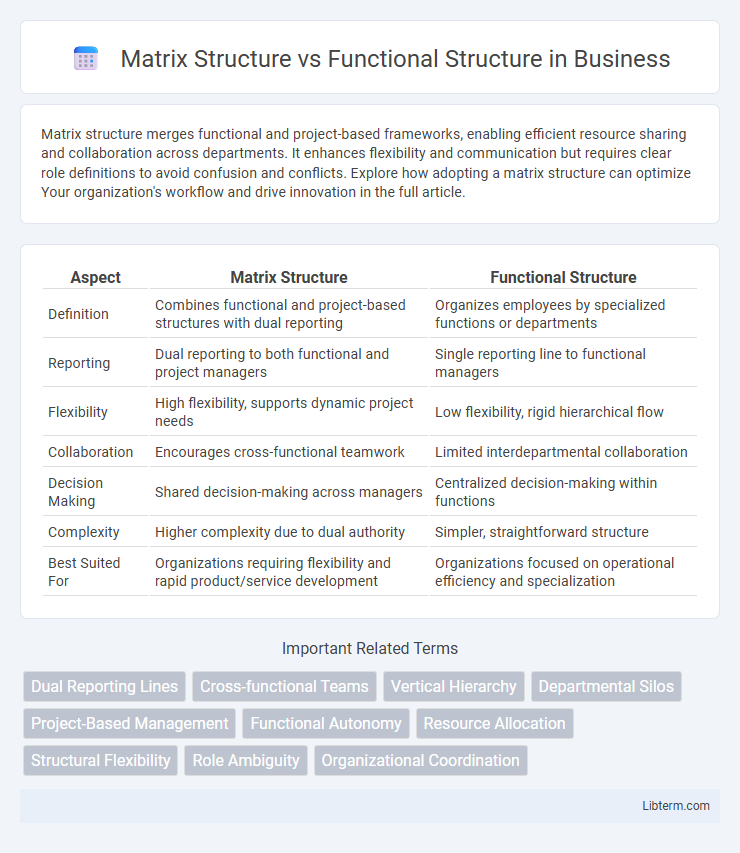Matrix structure merges functional and project-based frameworks, enabling efficient resource sharing and collaboration across departments. It enhances flexibility and communication but requires clear role definitions to avoid confusion and conflicts. Explore how adopting a matrix structure can optimize Your organization's workflow and drive innovation in the full article.
Table of Comparison
| Aspect | Matrix Structure | Functional Structure |
|---|---|---|
| Definition | Combines functional and project-based structures with dual reporting | Organizes employees by specialized functions or departments |
| Reporting | Dual reporting to both functional and project managers | Single reporting line to functional managers |
| Flexibility | High flexibility, supports dynamic project needs | Low flexibility, rigid hierarchical flow |
| Collaboration | Encourages cross-functional teamwork | Limited interdepartmental collaboration |
| Decision Making | Shared decision-making across managers | Centralized decision-making within functions |
| Complexity | Higher complexity due to dual authority | Simpler, straightforward structure |
| Best Suited For | Organizations requiring flexibility and rapid product/service development | Organizations focused on operational efficiency and specialization |
Introduction to Organizational Structures
Matrix structure combines functional and project-based divisions, allowing employees to report to multiple managers and promoting flexibility and collaboration across departments. Functional structure organizes employees strictly by specialized roles or departments, such as marketing, finance, or operations, enhancing operational efficiency and clear reporting lines. Both structures impact decision-making speed, communication flow, and adaptability in organizations depending on their complexity and strategy.
Overview of Matrix Structure
Matrix structure combines functional and project-based departments, enabling efficient resource sharing and collaboration across diverse teams. Employees report to both functional managers and project managers, which enhances flexibility and dynamic decision-making in complex projects. This dual authority system can improve innovation and responsiveness but may also require clear communication to avoid conflicts.
Overview of Functional Structure
Functional Structure organizes a company based on specialized departments such as marketing, finance, and operations, each led by a functional manager. This hierarchical framework promotes deep expertise, clear reporting lines, and operational efficiency within each function. It suits organizations aiming for standardized processes and reproducibility but may face challenges in interdepartmental communication and flexibility.
Key Differences Between Matrix and Functional Structures
Matrix structures integrate multiple reporting lines, allowing employees to report to both project and functional managers, enhancing flexibility and collaboration. Functional structures organize employees strictly by departments based on specialized roles, optimizing operational efficiency and expertise within distinct functions. The key difference lies in the complexity of authority and communication flow--matrix structures involve dual authority, while functional structures maintain clear, singular lines of command.
Advantages of Matrix Structure
Matrix structure enhances flexibility by allowing employees to report to multiple managers, which improves communication and collaboration across departments. It fosters efficient resource allocation and quicker decision-making by integrating diverse expertise and perspectives. This structure also supports innovation and adaptability, making it ideal for complex, dynamic projects requiring cross-functional teamwork.
Advantages of Functional Structure
The functional structure enhances operational efficiency by grouping employees based on specialized skills, enabling focused expertise and streamlined workflows. This hierarchy facilitates clear communication and accountability within departments, improving decision-making speed and reducing duplication of efforts. Cost-effectiveness is achieved as resources are optimized through standardized processes and centralized management.
Disadvantages of Matrix Structure
Matrix structures often result in role ambiguity and conflicts due to dual reporting lines, leading to confusion and decreased employee accountability. The increased complexity in communication and decision-making processes can slow down project progress and reduce operational efficiency. High demands on managers to balance multiple projects may cause stress and resource allocation challenges, negatively impacting overall organizational performance.
Disadvantages of Functional Structure
Functional structure often leads to communication barriers between departments, causing delays and reduced collaboration on cross-functional projects. It can create silos that hinder flexibility and responsiveness to market changes or customer needs. Limited employee skill development occurs as individuals tend to specialize narrowly within their functional area.
Choosing Between Matrix and Functional Structures
Choosing between matrix and functional structures depends on organizational complexity and project demands. Matrix structures enhance flexibility and collaboration by blending functional expertise with project-based teams, ideal for dynamic environments requiring cross-departmental coordination. Functional structures offer streamlined hierarchy and specialized roles, benefiting organizations focused on operational efficiency and clear departmental boundaries.
Conclusion: Which Structure Fits Your Organization Best?
Choosing between a matrix structure and a functional structure depends on your organization's size, complexity, and need for cross-functional collaboration. The matrix structure enhances flexibility and communication by allowing employees to report to multiple managers, ideal for dynamic industries requiring innovation and quick decision-making. In contrast, the functional structure offers clear hierarchy and specialization, best suited for organizations prioritizing operational efficiency and deep expertise within specific departments.
Matrix Structure Infographic

 libterm.com
libterm.com